by Winding Pathways | Mar 24, 2022 | (Sub)Urban Homesteading, Energy Efficiency
Many people dread the arrival of the monthly electric bill. We look forward to receiving it.
A few years ago, we hired Site Gen Solar to install an Enphase solar electric, or photovoltaic (PV), system on our barn roof. Although it’s a small system, when combined with our energy efficiency, monthly bills from Alliant Energy are tiny.
Our PV system does more for us than make electricity. It’s an instant weather scanner. We can access our Enphase app from anywhere and it tells us how much energy our system is producing in kilowatt-hours. One kilowatt-hour is enough energy to power a 100-watt light bulb for 10 hours. Our bulbs are LED and on average consume 12 watts.
On clear days our small system produces about 12-kilowatt hours. It powers our refrigerator, furnace fan, computers, and lights. When it produces more than we use, the excess goes out to the grid, subtracting cost from our bill.
The app tells us more. See these photos. When snow covers some panels, we can tell from the app that they weren’t producing much. When all panels are producing poorly, we know it’s a cloudy day or snow is covering all panels. Sometimes when we are traveling we open the app and learn about Cedar Rapids’ weather.
-

-
The Enphase app shows which panels are covered with snow.
-
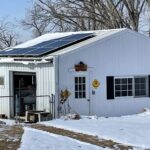
-
Production drops when panels are covered with snow or clouds cover the sun.
by Winding Pathways | Mar 17, 2022 | (Sub)Urban Homesteading, Garden/Yard, Garden/Yard
As we watched squirrels gleaning sunflower seeds from feeders in our backyard, we dined on 2021s sunshine!

Sweet potatoes are a healthy vegetable.
Thanks to last season’s sun our crop of sweet potatoes produced a bountiful crop, and we ate them until our last one became part of our February 8th dinner. We’ve only been growing sweet potatoes for a few years because we’d heard they need a long southern summer to mature. We now know that’s not true.
We love sweet potatoes. They come in many varieties and color shades from white to purple and the common ones with deep orange flesh. This nutritious plant originated from tropical South America and is now grown in warm regions all over the world. Sometimes they are called yams, but these two plants are distinctly different. Yams originated in Africa.
Nutritious Vegetable
We love the taste and nutrition of sweet potatoes but here are some other ways we love this plant:
- They are easy to grow. We buy “slips” and plant them in late May or early June.
- The plants and flowers are gorgeous, and slips are sometimes sold as ornamentals.
- They store well. We carefully dig them before the first frost, let them cure for a couple of weeks, and then store them in a cool dark place. They last all winter.
Sweet potatoes are easy. No freezing or canning is needed. We plant, weed a bit, dig, cure, and store and then enjoy eating them all winter. This year we’ve ordered a variety of sweet potato slips from Sand Hill Preservation Center and look forward to a larger harvest. The company also sells heritage chicken breeds and vegetable seeds.
by Winding Pathways | Mar 10, 2022 | (Sub)Urban Homesteading, Energy Efficiency
Only a few years ago few people had heard of lithium. Now almost everyone relies on this odd metal in their phone, laptop, and tools. It’s a world-changing element.
Metal????? Lithium is a truly odd metal. Iron, lead, and other common metals are heavy. Not lithium. It’s near the upper left corner of the periodic chart near hydrogen, the lightest element. Lithium is light, volatile, and scarce. Argentina and Chile, Australia, and China form the “lithium triangle” and hold the world’s greatest reserves. Smaller amounts are mined in the United States and other countries.
Many Uses
Lithium can jump. At least lithium-ion batteries can make a car jump. We experienced it when we drove a Chevy Bolt from Cedar Rapids to Dubuque. It’s an amazing car powered by energy stored in a lithium-ion battery, rather than gas. While driving on four-lane US 151 we stepped on the “gas” pedal and the Bolt jumped forward, swooping us around a sluggish car.
Lithium can also calm people down. For years it’s been an ingredient in drugs used to treat depression and bipolar disorder. The metal that makes a car jump can calm a person.
It’s also added to grease to make it even slicker.
Lithium Batteries
Lithium-ion batteries store plenty of energy, recharge quickly, and are making a huge change in American life. It started in 1991 when Sony used the first lithium-ion battery in camcorders. Since then, phones, tools, electronics, and even cars and trucks are powered by energy stored in these batteries.
We went “lithium-ion” a while back when we purchased Milwaukee Tool brand circular saws and drills. We were needlessly worried they wouldn’t be powerful and would run out of charge quickly. They were false fears. We love our battery tools and now have Milwaukee inflators, (i.e., to pump up tires), fans, and a pole saw. We also have EGO brand battery power lawn mowers, a trimmer, and a snowblower. They’re easy to use, quiet, and powerful. We love our battery-powered tools and can see a battery-energized car in our future.
-
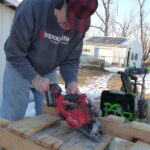
-
The battery gives a powerful charge.
-
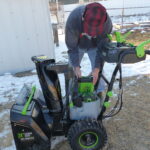
-
Batteries for the EGO snow blower are easy to charge.
-
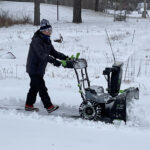
-
The EGO snow blower chews through heavy and light snow.
Pros and Cons
There are environmental and health benefits when using battery, or cordless, tools. They are quiet and don’t emit fumes. No need to pull a starter rope on the mower or blower anymore. Just flip a switch and vrrrooom! they go. Recharging batteries costs less than buying a comparable energy equivalent of gas, and there’s no flammable gas to lug home and store. It’s all good. There are downsides to lithium mining but the environmental positives outweigh them. Mining can be done responsibly.
Care of Lithium Batteries
Lithium-ion batteries are expensive but last a long time if given good care. Gerry Barnaby of EGO gave us these tips for battery care:
- Take the battery off the tool when it’s not in use.
- Protect batteries from extreme heat and cold. It’s a good idea to store them inside. EGO batteries are designed to discharge to 30% if not used for a few months at a stretch. It’s called “auto discharge” and light may flash, but this is normal. Just recharge the battery before using it.
- EGO batteries are designed to last for 1000 charges. To calculate the battery life divide 1000 by the times it’s used per year. So, if a battery is used 30 times a year it conceivably could last 33 years. But if you don’t believe it, cut those 33 years in half and cut it in half again and the end result is an eight-year life.
- When a battery is nearing the end of its life the run time will lessen. Then read a label on the side of the battery that gives a phone number. Call to learn where it can be recycled.
We’ll continue to invest in our battery-energized tools that are so easy to use.
by Winding Pathways | Mar 3, 2022 | (Sub)Urban Homesteading, Preparedness
Research Yields a Find
Part of our Winding Pathways business is writing travel and outdoor adventure articles for the Cedar Rapids GAZETTE and other publications. Preparedness blogs on our website encourage people to prepare for emergencies by keeping non-perishable food and other supplies on hand in a big plastic “preparedness” bin. So, we occasionally buy and try new products to test.

We found the meals tasty and filling.
While writing an article on Iowa backpacking, we bought a pouch of dehydrated food at SOKO in Czech Village. The brand was new to us. Backpackers know that dehydrated meals have a long shelf life, weigh little, and only need boiling water to prepare. They’re nutritious and even taste good. We keep about two weeks’ worth of dehydrated food in a storage bin just in case we have an extended power outage or emergency when we can’t access fresher food. We also sometimes take several meals with us when camping.
Busy Schedules
But we recently found a new value of dehydrated meals. We’d been busy. Very busy and had to skip a routine visit to the grocery store. Late one afternoon it was time to prepare dinner, but the refrigerator was bare. Because we’d just bought a pouch of Good to-Go brand dehydrated Chicken Gumbo to photograph for our article it was on the kitchen counter. We cooked it and enjoyed a pleasant backpacking meal while sitting at home.

Good To-Go chef Jennifer Scism creates delicious meals.
“Backpacking meals have come a long way since MRE (meals ready to eat) and there are options for diets ranging from gluten-free to keto and beyond. Good To-Go chef Jennifer Scism creates meals that are delicious and use only recognizable and pronounceable ingredients,” said Kate Ketschek of Revolution House Media and communications representative for Good To-Go meals.
The YUM Factor
We appreciated our recent meal simply because we hadn’t gotten to the grocery store and were hungry. The Chicken Gumbo tasted great on a cold snowy evening and was oh so convenient. Dehydrated meals have value beyond backpacking.
by Winding Pathways | Feb 17, 2022 | (Sub)Urban Homesteading, Geology/Weather, Reflections/Profiles
New England’s Nor’easter January 29-20, 2022
by Susan Fellows, guest blogger
What is a Nor-easter?
Dover, NH, 4:00 a.m. Temperature 5 degrees. The wind chill is probably close to -10 degrees. Wind gusts 40-45 mph throughout the day. What is a blizzard? Wind gusts more than 35 mph. Snow blowing and drifting. Visibility less than 1/4 mile. All more than three hours. We grew up with blizzards, know them well, and call them Nor’easters.
The description above is what I saw outside my living room window all day on January 29, 2022, in excess of eight hours. There is a large green space next to my apartment building with a stand of pine trees at the far end, where there is no snow. An area just outside my apartment going out about 20-30 feet where the wind blew the snow off all day long made it look like we had only a dusting of snow. Beyond that, snow accumulated up to 1″-2″ per hour for several hours. Most of the day, I could not see the trees which are less than a 1/4 mile away.
-
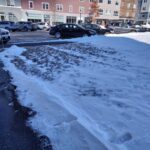
-
Strong winds swept some areas bare of snow.
-
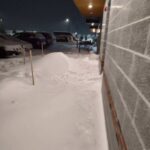
-
The building blocked the wind.
Following the Progress of the Storm
The well-predicted storm made its way up the coast from South Carolina, past Washington, DC, Philadelphia, and New York to New England. Snowfall reported in Bridgewater, MA, totaled 32″! Out at Wellfleet on the south side of Cape Cod, wind gusts reached 82 mph. Fortunately, in Dover, NH, we weren’t hit with as much snow and wind gusts were in the 40 mph range. Most of the day and into the evening I watched snow blowing horizontally past the windows. Whiteout! An all-day blizzard.
Venturing Out
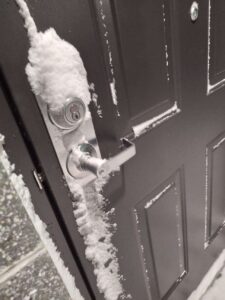
Opening the door was difficult
7:30 p.m. I decided to get my mail if there was any. True to the USPO motto, through rain, wind, snow, and dark of night the Post Office did deliver the mail! Getting out my door was difficult as the snow had accumulated to about three feet. So, it was hard to open the door. Along the sidewall of the building I trudged. Not as much snow there. But, once I reached the lobby door, I had to get to the security post to swipe my key fob to open that door. Snow spilled into my boots and I had to shove the door open about a foot to squeeze through. After picking up my mail, I made my way back to my apartment.
Manager & Snow Crews Respond to Safety Concern
The snowfall seemed to be easing up but it was hard to tell as the wind still picked up and carried snow horizontally past my window. Remembering that some Eastern big cities had had fires in apartments recently, I was concerned with conditions by the exit doors. So, I called the answering service of the apartment complex. Shortly our maintenance supervisor returned my call. I explained the situation and my concern that in case of an emergency requiring evacuation of the building the other residents might not be able to get safely out. He replied that the snow removal team would return the next morning. After some discussion, with the supervisor being unrelenting with his statement that the team would be back in the morning, I simply asked who would be liable if an evacuation were needed and people could not safely get out. Then, I hung up.
Soon after the property manager called, respected the fact that I was observing the conditions and he wasn’t. He called the supervisor of the snow removal team. Within the hour they arrived! I was relieved!
Blindingly Beautiful
Sunday, January 30, 2022. The day dawned bright and beautiful! What a change from not being able to see because of the blizzard! People were out with their pets and children enjoying the light, fluffy snow. The snow removal team cleared the overflow lots and residents moved their cars so the parking log could be properly cleared. Gigantic piles of snow were all over the place and sidewalks, doorways, and cars cleared of the eight inches of reported snow. One town, right on the ocean about 12 miles away, got the state’s grand total of 13.5″. The wind, she kept on blowing and the temperatures were bitterly, brutally cold.
-
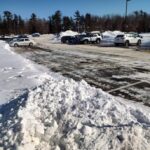
-
People moved their cars to help with snow removal.
-
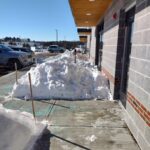
-
The doorways are cleared of snow.
-
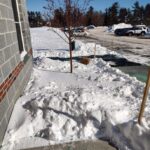
-
The snow removal team quickly cleared snow.
The next day, in appreciation, I called the supervisor to thank the crews for coming out in the storm and making sure residents were safe.
Prior to the storm, everyone had been told to stay off the roads, which they did. All-day Saturday, I had watched a storm tracker show from a Boston station. Indeed except for plows and utility crews restoring power, the roadways were clear of vehicles.
I LOVE SNOW and this was quite an event!
by Winding Pathways | Feb 3, 2022 | Birds, Garden/Yard, Nature, Uncategorized
Millions of families love watching chickadees, nuthatches and woodpeckers visit backyard feeders. A joyful daily task is bringing them a day’s supply of sunflower seeds, millet, or even cracked corn. But, often an important part of their diet is ignored.
Birds lack teeth so never need dental care. Instead, they must eat rocks! Small rocks humans call sand. Often birds forage along snowy roads gleaning grit spread to give cars traction. It goes into their gizzard where powerful muscles grind seeds into a digestible slurry that then moves on to the stomach.
During most of the year, birds find all the grit they need on their own, but when snow and ice seal off the soil they can’t find it. People sometimes scatter sand on slippery spots to provide human traction. Birds will glean some of it.
It’s helpful to sprinkle a handful of sand around feeders once a week during the snowy season. At Winding Pathways, we buy a 50-pound bag of chick grit at a local store that sells chicken feed. It’s fine ground hard rock that is ideal for both traction and bird digestion but plain old sand works.
Wild Turkeys often visit our feeders, so once in a while, we toss out large-sized grit, designed for laying hens. It helps their gizzards grind up hard corn kernels that they love snacking on.
An outstanding source of bird information is the Cornell University Laboratory of Ornithology.
-
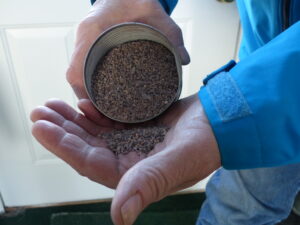
-
Chick grit is small.
-
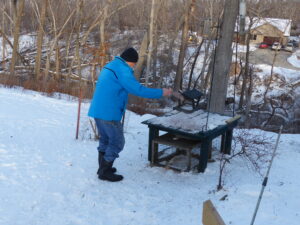
-
Sprinkle grit once a week to help birds in the snowy season.
-
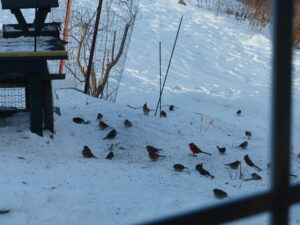
-
Birds flock to the seeds.

















